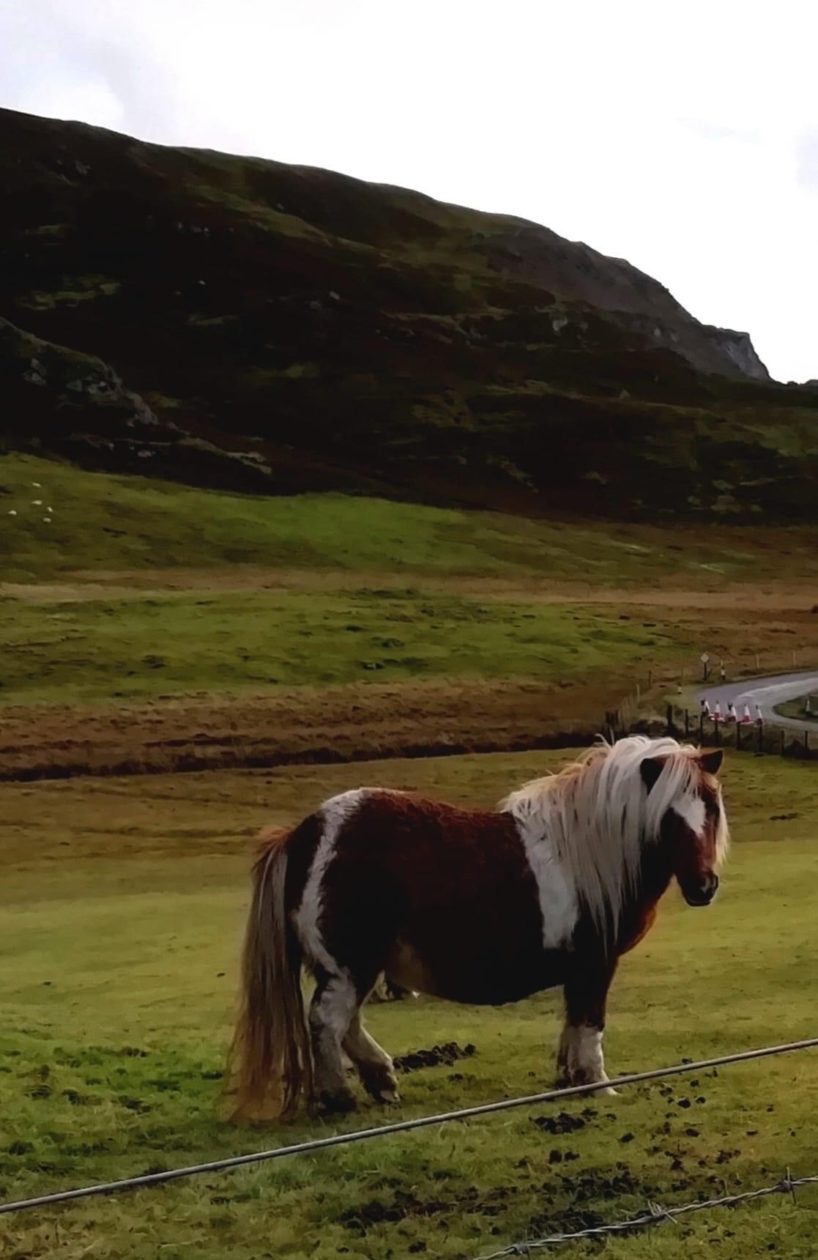Tingwall lies two miles north of Scalloway along a low-lying fertile valley with many wild blooms.
The name Tingwall is from ON Þingvöllr (field of the parliament). This is the ancient heart of Shetland, and it was at Law Ting Holm, an islet at the northern end of the Loch of Tingwall that the Norse held their annual Ting (Alting) or parliament. This islet was once entirely surrounded by water and accessed by a stone causeway. In the 1850s the level of the loch was lowered, and the holm took on its present form.
Today you find little obvious sign of the meeting place at Tingwall, but immediately to the north of the loch is Tingwall Kirk – a harled rectangular box, built between 1788 and 1790 with a belfry at its east end. The interior is largely original and has a gallery that extends around three sides of the church, supported on narrow columns. The fourth, south, side of the church is home to the enormously tall pulpit and its flanking windows. It was known as the “Mother Church” of Shetland due to the mound of grass in the graveyard that has a stone front and is home home to a burial vault. This is all that remains of St Magnus Church, built in the late 1100s.
St Magnus was one of three churches gifted by three Norse sisters to Shetland. All had round towers, and St Magnus Church was said to be the grandest of them. From 1215 St Magnus was the base of the Archdeacon of Tingwall, the senior church official in Shetland.
| St Magnus was demolished in 1788, at around the same time as the other two churches gifted by the three Norse sisters. As one Shetland commentator put it: “…as a principle of barbarous economy to supply stones at a cheap rate for the plain Presbyterian churches which now occupy their places. |
There are a number of ancient and historical monuments in Tingwall, including a standing stone known as the murder stone. This stone is traditionally said to be the site where the Earl of Orkney killed his cousin in a power struggle over Shetland. Local folklore also suggests that a person could escape punishment at the Thing if they were able to run to the stone and claim sanctuary. Other versions of this story involve running to the Kirk, or the nearby croft at Griesta.
The lochs of Asta and Tingwall are almost joined together and are full of trout, a real treat for anglers.
If you are keen on walking, the chain of hill lochs to the west of Tingwall makes an enjoyable day out.
Asta Golf Club’s nine-hole course, lying between the road and the lochs, is open to visitors and small groups. The clubhouse is also the venue for fortnightly musical evenings throughout the year.
Tingwall Airport is the base for regular inter-island flights to the outer isles. Flight operators Airtask also offer short airborne sight-seeing trips.
The Loch of Strand in the northern part of Tingwall valley is a good loch for sea and brown trout fishing and has nesting swans and ducks.
Laxfirth was the site of Hanseatic trading with Germany in days past. Laxfirth House at the head of the voe has been the home of the present family for over a hundred years. On the point of the east side of the voe, at Hawks Ness, are the remains of a broch.
There are fine walks and good views of Dales Voe and north from the Califf and Braewick areas.
The rocks that make up the central ‘spine’ of Shetland are the roots of the ancient Caledonian Mountain Chain, the remains of which can be seen as far afield as North America, Greenland, Scandinavia, Scotland and Ireland.
The small settlement of Girlsta has Shetland’s largest and deepest loch. The island in the middle of the loch is said to be the last resting place of Geirhildr, who drowned in the loch in 870AD while accompanying her father on a trip to Iceland.
The name Girlsta is from ON Geirhildarstaðir (woman’s name).
Girlsta loch is a Site of Special Scientific Interest (SSSI) and Shetland Anglers’ Association request that any char caught are returned alive.
Tingwall Primary School has a catchment area which includes Wadbister, Girlsta and Griesta. Tingwall is a thriving community and its close proximity to Lerwick (6 miles) and recent housing development, has brought several young families into the area.
The Tingwall Public Hall, adjacent to the school, is regularly used by both the school and the wider community.
It is used by the school for PE and concerts and is used for various other events such as; the Scalloway Fire Festival, Youth Clubs, Sunday Teas, Box-fit, Mothers and Toddlers groups, SWRI, knitting groups, plant sales, weddings and birthday parties and numerous live music and charity events.
The School Playground area is open to the public outwith school hours. No dogs are allowed in the playground at any time.
Located within the community is there are some small businesses such as a Garden Centre and Auto Repair Garage, Car Valeting Service and Grave Stone Engraving. The school has forged close links with Pete Glanville’s organic croft and pupils are given the chance to visit the croft.

